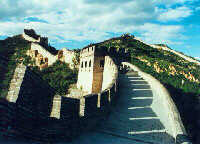From the Bohai Sea in the East to Dunhuang's desert plains in the West, the
Great Wall snakes its way across precipitous, rocky ridges, sometimes even
stretching across iron beams to bridge windy chasms.
 Famed for its sheer size the Great Wall spans over about 4,500 miles (7,300
km) from east to west throughout northern China. From the Shanhaiguan Pass to
Jiayuguan Pass, the Wall snakes across ridges and deserts via Liaoning, Hebei,
Tianjin, Beijing, Shanxi, Inner Mongolia, Shaanxi, Ningxia, and finally ends in
Gansu. The mighty presence of the Great Wall stands as a witness of the
country's enthralling history.
Famed for its sheer size the Great Wall spans over about 4,500 miles (7,300
km) from east to west throughout northern China. From the Shanhaiguan Pass to
Jiayuguan Pass, the Wall snakes across ridges and deserts via Liaoning, Hebei,
Tianjin, Beijing, Shanxi, Inner Mongolia, Shaanxi, Ningxia, and finally ends in
Gansu. The mighty presence of the Great Wall stands as a witness of the
country's enthralling history.
The Great Wall is considered one of the greatest wonders of the world.
Although some of its sections are now in ruins or have disappeared completely,
it is still one of the most sought-after attractions in the world thanks to its
magnificence and great significance. In 1987, the Great Wall was enlisted as a
World Heritage site by UNESCO.
History
No one can tell precisely when the Great Wall's construction began, but it is
believed that it originated as a military fortification against invading tribes
along the borders during the early Zhou Dynasty. Late in the Spring and Autumn
Period (770- 476BC), the ducal states extended their defense work and built
"great" structures to prevent attacks from other states. It was not until the
Qin Dynasty (221-206BC) that the separate walls, constructed by the states of
Qin, Yan and Zhao kingdoms, were connected to form a defensive system along the
northern border by Emperor Qin Shi Huang (also called Qin Shi Huangdi by
westerners or the "First Emperor"). After the emperor unified the country in
214BC, he ordered the construction of the wall. It took about 10 years to finish
the wall, which stretched from Linzhao (eastern part of Gansu Province) in the
west to Liaodong (Jilin Province) in the east. The wall not only served as a
defense structure in the north but also symbolized the emperor's power.
From the Qin Dynasty onwards, Xiongnu, an ancient tribe that lived in North
China, frequently harassed the country's northern border. During the Han
Dynasty, Emperor Wu (Han Wu Di) sent three expeditions to fight the Xiongnu in
127BC, 121BC and 119BC. The Xiongnu were driven into the far north of the Gobi.
To maintain the safety of the Hexi Corridor (Gansu Province), the emperor
ordered the extension of the Great Wall westward to the the Hexi Corridor and
Xinjiang region. The ruins of the beacon towers and debris of the Han Wall are
still discernible in Dunhuang, Yumen and Yangguan. A recent report shows that
the Han Wall ruins have been discovered near Lopnur in China's Xinjiang region.